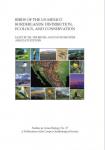Distribution and Status of Breeding Landbirds in Northern Sonora Mexico
Northern Sonora, Mexico is dominated by steep elevation and rainfall gradients and a variety of vegetation communities with affinity to the Sonoran, Madrean, Sinaloan, and Chihuahuan biogeographic provinces. Despite high environmental diversity and moderate accessibility, current information on distribution and abundance of breeding landbirds is limited throughout much of this vast region. Between 2000 and 2007, I surveyed landbirds in northern Sonora in four of the six primary watersheds that occur within 125 km of the US. I detected 161 species of landbirds that I presumed were breeding (59% confirmed) and four additional species that were possibly breeding during 568 site visits to 306 localities. I did not detect seven species that had been presumed to breed in the past, six of which likely still occur, or 10 species that I suspect may breed locally or irregularly in the study area. Based on probabilistic methods, I estimate that as many as 178 species of land- birds likely breed in the study area. Species richness within each of 16 secondary watershed regions increased as the number of major vegetation communities that were present increased, and presence of broadleaf riparian woodland, Madrean evergreen woodland, and Madrean montane conifer forest had the greatest influence on richness. Geographic ranges of many species that I observed were much larger than that suggested by previous studies likely as a result of increased effort. Evidence for some species however, suggested that distributions have either expanded or contracted, likely as a result of major changes in vegetation and perhaps climate change. Although some populations await discovery, my findings suggest that northern Sonora supports higher richness of breeding landbirds than any other region of similar area in the borderlands of northern Mexico.

